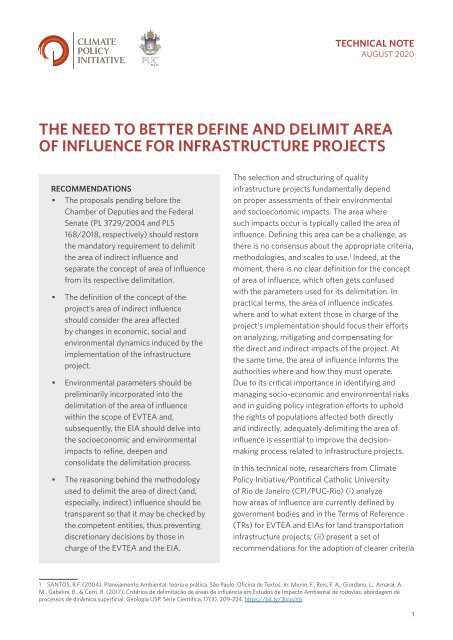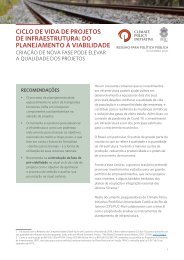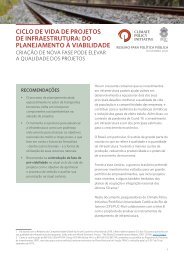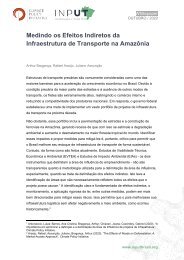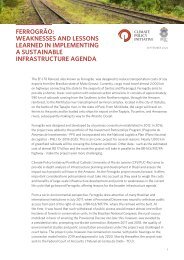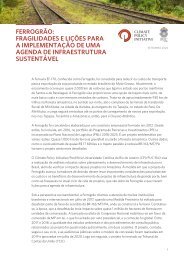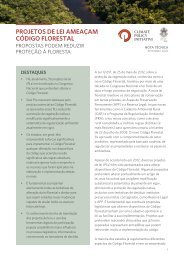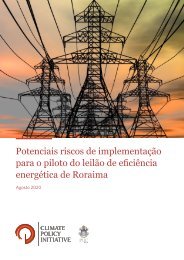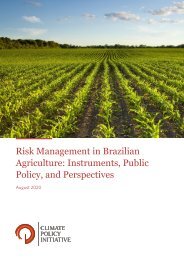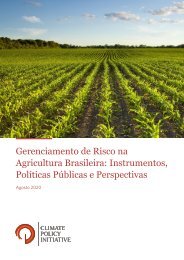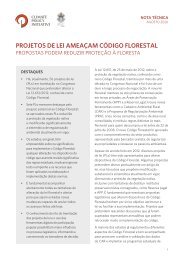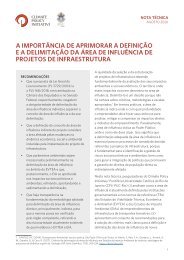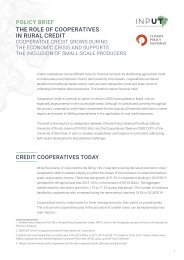The Need to Better Define and Delimit Area of Influence for Infrastructure Projects
Create successful ePaper yourself
Turn your PDF publications into a flip-book with our unique Google optimized e-Paper software.
TECHNICAL NOTE<br />
AUGUST 2020<br />
THE NEED TO BETTER DEFINE AND DELIMIT AREA<br />
OF INFLUENCE FOR INFRASTRUCTURE PROJECTS<br />
RECOMMENDATIONS<br />
• <strong>The</strong> proposals pending be<strong>for</strong>e the<br />
Chamber <strong>of</strong> Deputies <strong>and</strong> the Federal<br />
Senate (PL 3729/2004 <strong>and</strong> PLS<br />
168/2018, respectively) should res<strong>to</strong>re<br />
the m<strong>and</strong>a<strong>to</strong>ry requirement <strong>to</strong> delimit<br />
the area <strong>of</strong> indirect influence <strong>and</strong><br />
separate the concept <strong>of</strong> area <strong>of</strong> influence<br />
from its respective delimitation.<br />
• <strong>The</strong> definition <strong>of</strong> the concept <strong>of</strong> the<br />
project’s area <strong>of</strong> indirect influence<br />
should consider the area affected<br />
by changes in economic, social <strong>and</strong><br />
environmental dynamics induced by the<br />
implementation <strong>of</strong> the infrastructure<br />
project.<br />
• Environmental parameters should be<br />
preliminarily incorporated in<strong>to</strong> the<br />
delimitation <strong>of</strong> the area <strong>of</strong> influence<br />
within the scope <strong>of</strong> EVTEA <strong>and</strong>,<br />
subsequently, the EIA should delve in<strong>to</strong><br />
the socioeconomic <strong>and</strong> environmental<br />
impacts <strong>to</strong> refine, deepen <strong>and</strong><br />
consolidate the delimitation process.<br />
• <strong>The</strong> reasoning behind the methodology<br />
used <strong>to</strong> delimit the area <strong>of</strong> direct (<strong>and</strong>,<br />
especially, indirect) influence should be<br />
transparent so that it may be checked by<br />
the competent entities, thus preventing<br />
discretionary decisions by those in<br />
charge <strong>of</strong> the EVTEA <strong>and</strong> the EIA.<br />
<strong>The</strong> selection <strong>and</strong> structuring <strong>of</strong> quality<br />
infrastructure projects fundamentally depend<br />
on proper assessments <strong>of</strong> their environmental<br />
<strong>and</strong> socioeconomic impacts. <strong>The</strong> area where<br />
such impacts occur is typically called the area <strong>of</strong><br />
influence. Defining this area can be a challenge, as<br />
there is no consensus about the appropriate criteria,<br />
methodologies, <strong>and</strong> scales <strong>to</strong> use. 1 Indeed, at the<br />
moment, there is no clear definition <strong>for</strong> the concept<br />
<strong>of</strong> area <strong>of</strong> influence, which <strong>of</strong>ten gets confused<br />
with the parameters used <strong>for</strong> its delimitation. In<br />
practical terms, the area <strong>of</strong> influence indicates<br />
where <strong>and</strong> <strong>to</strong> what extent those in charge <strong>of</strong> the<br />
project’s implementation should focus their ef<strong>for</strong>ts<br />
on analyzing, mitigating <strong>and</strong> compensating <strong>for</strong><br />
the direct <strong>and</strong> indirect impacts <strong>of</strong> the project. At<br />
the same time, the area <strong>of</strong> influence in<strong>for</strong>ms the<br />
authorities where <strong>and</strong> how they must operate.<br />
Due <strong>to</strong> its critical importance in identifying <strong>and</strong><br />
managing socio-economic <strong>and</strong> environmental risks<br />
<strong>and</strong> in guiding policy integration ef<strong>for</strong>ts <strong>to</strong> uphold<br />
the rights <strong>of</strong> populations affected both directly<br />
<strong>and</strong> indirectly, adequately delimiting the area <strong>of</strong><br />
influence is essential <strong>to</strong> improve the decisionmaking<br />
process related <strong>to</strong> infrastructure projects.<br />
In this technical note, researchers from Climate<br />
Policy Initiative/Pontifical Catholic University<br />
<strong>of</strong> Rio de Janeiro (CPI/PUC-Rio) (i) analyze<br />
how areas <strong>of</strong> influence are currently defined by<br />
government bodies <strong>and</strong> in the Terms <strong>of</strong> Reference<br />
(TRs) <strong>for</strong> EVTEA <strong>and</strong> EIAs <strong>for</strong> l<strong>and</strong> transportation<br />
infrastructure projects; (ii) present a set <strong>of</strong><br />
recommendations <strong>for</strong> the adoption <strong>of</strong> clearer criteria<br />
1 SANTOS, R.F. (2004). Planejamen<strong>to</strong> Ambiental: teoria e prática. São Paulo: Oficina de Tex<strong>to</strong>s. In: Menin, F., Reis, F. A., Giordano, L., Amaral, A.<br />
M., Gabelini, B., & Cerri, R. (2017). Critérios de delimitação de áreas de influência em Estudos de Impac<strong>to</strong> Ambiental de rodovias: abordagem de<br />
processos de dinâmica superficial. Geologia USP. Série Científica, 17(3), 209-224. https://bit.ly/3hrxvY6.<br />
1
<strong>for</strong> the definition <strong>and</strong> demarcation <strong>of</strong> areas <strong>of</strong> influence <strong>for</strong> new projects, from a perspective that<br />
explicitly incorporates where the direct <strong>and</strong> indirect effects <strong>of</strong> this type <strong>of</strong> undertaking will occur;<br />
<strong>and</strong> (iii) propose a dialogue between the EVTEA <strong>and</strong> the EIA.<br />
In Brazil, the area <strong>of</strong> influence <strong>of</strong> infrastructure projects is currently delimited in two moments:<br />
in the Feasibility Studies (Estudo de Viabilidade Técnica, Econômico e Ambiental - EVTEA), which<br />
aims <strong>to</strong> assess the economic feasibility <strong>of</strong> the project, <strong>and</strong> the Environmental Impact Assessment<br />
(Estudo de Impac<strong>to</strong> Ambiental - EIA), meant <strong>to</strong> evaluate the project’s environmental feasibility.<br />
<strong>The</strong>re is a difference in the objective <strong>and</strong> scope between these two instruments which, in itself,<br />
may lead <strong>to</strong> different delimitations <strong>of</strong> projects’ areas <strong>of</strong> influence. On the other h<strong>and</strong>, both<br />
instruments, in theory, apply <strong>to</strong> the same project, which means that it is reasonable <strong>to</strong> expect<br />
that their areas <strong>of</strong> influence should somehow be related.<br />
Within the scope <strong>of</strong> the EIA, changes <strong>to</strong> determine area <strong>of</strong> influence are currently under<br />
discussion by Brazil’s National Congress. General Environmental Licensing Bill (Legislative<br />
Bill PL 3,729/2004) <strong>and</strong> Senate Bill PLS 168/2018, both aimed at changing environmental<br />
licensing rules, restrict the concept <strong>of</strong> area <strong>of</strong> influence, proposing that it applies only <strong>to</strong> <strong>Area</strong>s<br />
<strong>of</strong> Direct <strong>Influence</strong> (Área de Influência Direta - AID), where only the direct impacts <strong>of</strong> projects<br />
are considered. In current practice, however, terms <strong>of</strong> reference <strong>for</strong> EIAs usually m<strong>and</strong>ate the<br />
establishment <strong>of</strong> both an AID <strong>and</strong> an <strong>Area</strong> <strong>of</strong> Indirect <strong>Influence</strong> (Área de Influência Indireta -<br />
AII) as parameter <strong>of</strong> study. Such proposals <strong>to</strong> restrict the concept <strong>of</strong> area <strong>of</strong> influence would,<br />
there<strong>for</strong>e, preclude the need <strong>to</strong> assess the indirect effects <strong>of</strong> building <strong>and</strong> operating the<br />
projects. As a logical consequence, they also exclude these indirect effects from future socioenvironmental<br />
mitigation <strong>and</strong> compensation programs.<br />
<strong>The</strong> a<strong>for</strong>ementioned legislative bills also draw on the concept <strong>of</strong> area <strong>of</strong> influence <strong>to</strong> determine<br />
the right <strong>to</strong> participate in the decision-making process, both by limiting public hearings<br />
exclusively <strong>to</strong> people located in the areas directly influenced by the project <strong>and</strong> by restricting the<br />
intervention <strong>of</strong> bodies <strong>and</strong> entities from outside the AIDs. 2<br />
DIFFERENT DEFINITIONS USED BY ANTT,<br />
VALEC AND CONAMA<br />
According <strong>to</strong> the Brazilian L<strong>and</strong> Transportation Regula<strong>to</strong>ry Agency (Agência Nacional de<br />
Transportes Terrestres - ANTT), an area <strong>of</strong> influence is “the part <strong>of</strong> a terri<strong>to</strong>ry where the effects <strong>of</strong><br />
the existence <strong>of</strong> a transport <strong>of</strong>fering can be perceived”. Under this definition, ANTT subdivides<br />
the area <strong>of</strong> influence in<strong>to</strong> two parts: (i) direct or nearby, i.e., an area occupied by habitual users <strong>of</strong><br />
transport facilities, <strong>and</strong> (ii) remote, where the indirect effects <strong>of</strong> a transport <strong>of</strong>fering take place. 3<br />
VALEC also classifies areas <strong>of</strong> influence as direct or indirect, but adopts a more comprehensive<br />
definition than that <strong>of</strong> ANTT. According <strong>to</strong> VALEC, an area <strong>of</strong> direct influence is composed <strong>of</strong><br />
geographical units that constitute potential hubs <strong>for</strong> the loading or passing <strong>of</strong> railroads, whereas<br />
an area <strong>of</strong> indirect influence is composed <strong>of</strong> geographical units that will be impacted by new<br />
railroad either by potentially attracting new loads or by diverting the load flow. According <strong>to</strong> the<br />
2 <strong>The</strong> intervening bodies are: FUNAI (National Indigenous Foundation), Palmares Cultural Foundation, IPHAN (National His<strong>to</strong>ric <strong>and</strong> Artistic<br />
Heritage Institute), the Ministry <strong>of</strong> Health, ICMBio (Chico Mendes Institute <strong>for</strong> Biodiversity Conservation) <strong>and</strong> INCRA (National Institute <strong>for</strong><br />
Colonization <strong>and</strong> Agrarian Re<strong>for</strong>m).<br />
3 ANTT Resolution No. 3,054 <strong>of</strong> 03/05/2009.<br />
2
VALEC’s manual, the delimitation <strong>of</strong> areas <strong>of</strong> direct <strong>and</strong> indirect influence must be justified <strong>to</strong><br />
show, unequivocally, the interactions between the railroad <strong>and</strong> the geographical area.<br />
<strong>The</strong>se agencies use the definition <strong>of</strong> areas <strong>of</strong> direct <strong>and</strong> indirect influence interchangeably<br />
with the concept <strong>of</strong> area delimitation. <strong>The</strong>y also believe that different criteria should be taken<br />
in<strong>to</strong> account in the delimitation process, which may cause some confusion, as these are two<br />
au<strong>to</strong>nomous agencies <strong>and</strong> yet both deal with l<strong>and</strong> transportation. <strong>The</strong> definitions also use<br />
certain terms as parameters that are only related with the economic feasibility <strong>of</strong> the project.<br />
However, the EVTEA also has an environmental component, allowing <strong>for</strong> the possible existence<br />
<strong>of</strong> environmental parameters when delimiting areas <strong>of</strong> influence.<br />
<strong>The</strong> National Environment Council (Conselho Nacional do Meio Ambiente - CONAMA), in turn,<br />
provides a general definition stating that the area <strong>of</strong> influence <strong>of</strong> a project is the “geographical<br />
area <strong>to</strong> be directly or indirectly affected by the impacts”. 4 In practice, the terms <strong>of</strong> reference (TRs)<br />
<strong>for</strong> preparing the EIA go further <strong>and</strong> state that the area <strong>of</strong> influence <strong>of</strong> a given project corresponds<br />
<strong>to</strong> the delimitation <strong>of</strong> the geographical area that will be directly affected by the project <strong>and</strong> <strong>to</strong> the<br />
areas under its indirect influence. In this case, it should be noted that the definition <strong>of</strong> the area <strong>of</strong><br />
influence uses the actual delimitation <strong>of</strong> the area.<br />
It is underst<strong>and</strong>able that the definition is linked <strong>to</strong> delimitation - after all, it is a geographical area<br />
that must be identified based on certain criteria so that the socio-economic <strong>and</strong> environmental<br />
impacts <strong>of</strong> a project can be mapped. However, separating the two concepts - “definition” <strong>and</strong><br />
“delimitation” - can make everything clearer - both when <strong>for</strong>mulating the terms <strong>of</strong> reference <strong>for</strong><br />
the EVTEA <strong>and</strong> the EIA, <strong>to</strong> indicate which criteria or methodology should guide the delimitation<br />
<strong>of</strong> the area <strong>of</strong> influence, <strong>and</strong> when determining who will design the studies.<br />
DELIMITATION OF AREAS OF INFLUENCE<br />
IN THE EVTEA AND EIA TERMS OF REFERENCE<br />
<strong>The</strong> area <strong>of</strong> influence is delimited in two moments within the life cycle <strong>of</strong> a project: in the<br />
EVTEA <strong>and</strong> the EIA - i.e., in the phase when l<strong>and</strong> transportation infrastructure projects undergo<br />
feasibility assessments.<br />
Due <strong>to</strong> the nature <strong>of</strong> these studies, it would make sense <strong>for</strong> the EVTEA <strong>to</strong> preliminarily delimit<br />
the area <strong>of</strong> influence <strong>and</strong> then the EIA would delve in<strong>to</strong> the socioeconomic <strong>and</strong> environmental<br />
impacts, thus consolidating the delimitation process. This is not necessarily what happens, not<br />
least because there is no legal obligation <strong>for</strong> the EVTEA <strong>to</strong> be carried out prior <strong>to</strong> the EIA.<br />
Despite the differences between the criteria employed by ANTT <strong>and</strong> VALEC, both consider areas<br />
<strong>of</strong> both direct <strong>and</strong> indirect influence in their respective definitions. In practice, however, the scope<br />
<strong>of</strong> EVTEA is limited <strong>to</strong> the area <strong>of</strong> direct influence <strong>of</strong> l<strong>and</strong> transportation projects. 5 It should also<br />
be noted that the studies do not justify the delimitation <strong>of</strong> the area <strong>of</strong> influence <strong>and</strong>, in the case<br />
<strong>of</strong> railroad projects, contain no indication as <strong>to</strong> whether the in<strong>for</strong>mation <strong>and</strong> data provided in the<br />
VALEC’s manual <strong>for</strong> EVTEA preparation manual were, in fact, heeded. 6<br />
4 CONAMA Resolution No. 01, <strong>of</strong> January 23, 1986.<br />
5 <strong>The</strong> EVTEA <strong>for</strong> the following projects were analyzed: Ferrogrão, Ferronorte (Cuiabá-Santarém), FICO (Por<strong>to</strong> Velho - Vilhena), Norte-Sul<br />
(Açailândia-Palmas), BR-364 (Rondonópolis / MT-Jataí / GO) <strong>and</strong> BR-163 (Sinop / MT-Miritituba / PA)<br />
6 Ibid.<br />
3
In terms <strong>of</strong> environmental licensing, the EIA terms <strong>of</strong> reference deal with areas <strong>of</strong> direct <strong>and</strong><br />
indirect influence according <strong>to</strong> their peculiarities (e.g., if it is an area with indigenous l<strong>and</strong><br />
present) 7 <strong>and</strong> the impacts <strong>to</strong> which they will be subjected (e.g., population growth, increased<br />
service <strong>of</strong>ferings, etc.). As such, the following parameters must be used: the watershed where the<br />
project will be undertaken, the dynamics <strong>of</strong> l<strong>and</strong> use <strong>and</strong> occupation, as well as social indica<strong>to</strong>rs,<br />
predominant ecosystems, <strong>and</strong> indica<strong>to</strong>rs relevant <strong>to</strong> biodiversity conservation in the region<br />
(watersheds, vegetation cover, etc.). It should be noted that not all parameters are objective by<br />
nature, thus making it important <strong>for</strong> the methodology used in delimiting the area <strong>of</strong> influence <strong>to</strong><br />
be explicitly stated in the EIA.<br />
<strong>The</strong> EIA’s terms <strong>of</strong> reference provide <strong>for</strong> three types <strong>of</strong> areas <strong>of</strong> influence delimitation: Directly<br />
Affected <strong>Area</strong>s (Área Diretamente Afetada - ADA), <strong>Area</strong>s <strong>of</strong> Direct <strong>Influence</strong> (Área de Influência<br />
Direta - AID) <strong>and</strong> <strong>Area</strong>s <strong>of</strong> Indirect <strong>Influence</strong> (Área de Influência Indireta - AII):<br />
• ADA: <strong>Area</strong>s that will undergo direct interventions due <strong>to</strong> activities inherent <strong>to</strong> the project<br />
(areas affected by construction, vegetation removal, access routes, stations <strong>and</strong> yards,<br />
support structures, works <strong>of</strong> art, loaned areas, deposits, dumps, etc.).<br />
• AID: <strong>Area</strong>s actually or potentially threatened by the direct impacts <strong>of</strong> the project’s<br />
implementation <strong>and</strong> operation, as well as associated <strong>and</strong> resulting activities. In addition <strong>to</strong><br />
these minimum guidelines, other areas <strong>to</strong> be incorporated or added <strong>to</strong> the <strong>Area</strong> <strong>of</strong> Direct<br />
<strong>Influence</strong> may need <strong>to</strong> be delimited as well, depending on physical, biological, social <strong>and</strong><br />
economic characteristics <strong>and</strong> the specificities <strong>of</strong> the project in question.<br />
• AII: <strong>The</strong> region that will be affected by the indirect impacts <strong>of</strong> the construction project,<br />
considering the physical, biotic <strong>and</strong>, mainly, socioeconomic environments, as related <strong>to</strong><br />
changes in the dynamics <strong>of</strong> l<strong>and</strong> use <strong>and</strong> occupation, in the dynamics <strong>of</strong> urban centers <strong>and</strong><br />
in the flow <strong>and</strong> transport dynamics at the regional level. For the socioeconomic environment<br />
criterion, the AII must cover, at the very least, the terri<strong>to</strong>ries <strong>of</strong> the municipalities that cross<br />
the project.<br />
Within the scope <strong>of</strong> the federal environmental licensing, although the delimitation <strong>of</strong> areas <strong>of</strong><br />
influence is st<strong>and</strong>ardized in the terms <strong>of</strong> reference <strong>of</strong> the EIAs, in practice different studies use<br />
different criteria <strong>and</strong> fail <strong>to</strong> include the rationale behind the delimitation process.<br />
As an example at the federal level, an EIA carried out <strong>for</strong> the Midwest Integration Railroad<br />
(Ferrovia de Integração do Centro-Oeste - FICO, or simply EF 354) determined that the area<br />
<strong>of</strong> direct influence <strong>for</strong> the biotic environment would encompass a radius <strong>of</strong> 5 km on either<br />
side <strong>of</strong> the railroad. For the physical environment, it was 2.5 km on either side, <strong>and</strong> <strong>for</strong> the<br />
socioeconomic environment, it was the <strong>to</strong>tal area <strong>of</strong> the municipalities directly sectioned by the<br />
railroad layout. It also considered a 10km-radius <strong>for</strong> each area <strong>for</strong> archeology purposes <strong>and</strong> 50<br />
km <strong>for</strong> anthropology. When delimiting the area <strong>of</strong> indirect influence, the EIA pooled the physical<br />
<strong>and</strong> biotic aspects <strong>to</strong>gether <strong>and</strong> delimited a 50 km-radius, with 25 km on each side. From a<br />
7 <strong>The</strong> Interministerial Ordinance 060/2015 regulates the participation <strong>of</strong> governmental bodies in the environmental licensing procedure. In<br />
its annex 1, it establishes a radius in the project’s surrounding in which it assumes interference in certain areas, such as indigenous l<strong>and</strong> <strong>and</strong>/<br />
or quilombola communities, <strong>and</strong> requires the participation <strong>of</strong> the governmental bodies responsible <strong>for</strong> managing these areas in the licensing<br />
procedure. This radius may be used, in a practical sense, as a parameter <strong>to</strong> delimit the AID. However, the ordinance only regulates the participation<br />
<strong>of</strong> governmental bodies <strong>for</strong> this purpose. Additionally, the radius only establishes a minimum distance <strong>for</strong> which the participation <strong>of</strong> governmental<br />
bodies in the environmental licensing procedure, however depending on the EIA or other evidence gathered in the environmental licensing procedure<br />
participation could be required within a longer distance. See: TRF-1. Agravo de Instrumen<strong>to</strong>. Ag n°0005755-44.2017.4.01.0000. Rel: Des. Federal<br />
Daniel Paes Ribeiro. e-DJF1 16/02/2017 PAG 706. Available at: https://bit.ly/32QXILO. Accessed on July 17, 2020.<br />
4
socioeconomic perspective, it encompassed the <strong>to</strong>tal area <strong>of</strong> the municipalities located within 10<br />
km <strong>of</strong> the project’s layout.<br />
<strong>The</strong> Ferronorte (EF 364) project, on the other h<strong>and</strong>, used different criteria <strong>to</strong> delimit the<br />
area <strong>of</strong> direct influence. One <strong>of</strong> the EIAs conducted <strong>for</strong> the project concluded that the AID<br />
should be the same <strong>for</strong> the biotic <strong>and</strong> physical environment <strong>and</strong> considered as a parameter<br />
the micro basins that would be crossed by the project, as well as the l<strong>and</strong>scape - especially<br />
<strong>for</strong>est fragments located near the planned route. As <strong>for</strong> the socioeconomic environment, the<br />
EIA considered the two municipalities that would be most affected by the construction <strong>of</strong> the<br />
railroad. When calculating the area <strong>of</strong> indirect influence <strong>for</strong> the physical <strong>and</strong> biotic environment,<br />
the EIA considered a radius <strong>of</strong> 10 km on either side <strong>of</strong> the railroad <strong>and</strong>, <strong>for</strong> the socioeconomic<br />
environment, concluded that all municipalities surrounding the railroad would suffer indirect<br />
effects from the project.<br />
It should be noted that the same type <strong>of</strong> project in two locations had ADAs, AIDs, <strong>and</strong> AIIs<br />
delimited using different criteria, <strong>and</strong> both studies failed <strong>to</strong> transparently explain how these<br />
delimitations had been determined. Granted, differences can be expected given that the projects<br />
are located in different regions, each with its own peculiarities <strong>and</strong> sensibilities. However,<br />
technical rationale is needed <strong>to</strong> justify the delimitation, as the methodological decisions made<br />
should be publicly available.<br />
AREA OF INFLUENCE AND THE MARKET ACCESS APPROACH<br />
Researchers from CPI/PUC-Rio have developed a “market access” methodology that serves<br />
as the first step in delimiting the area <strong>of</strong> influence <strong>of</strong> transportation infrastructure projects <strong>and</strong><br />
computing the socio-environmental impacts <strong>of</strong> their operation. Using operational research<br />
algorithms <strong>to</strong> estimate transport costs <strong>for</strong> all pairs <strong>of</strong> municipalities in the country (<strong>and</strong> between<br />
each municipality <strong>and</strong> its nearest port), the researchers assist decision makers <strong>to</strong> predict which<br />
municipalities will be impacted by a given investment in transport infrastructure <strong>and</strong> measure the<br />
size <strong>of</strong> such impact on an accessibility measure entitled “market access”.<br />
This approach illustrates just how problematic it is <strong>to</strong> define an area <strong>of</strong> influence based solely<br />
on a radius around the project or on a fixed range <strong>of</strong> kilometers along highways or railroads. To<br />
illustrate, consider the definition <strong>of</strong> a road’s area <strong>of</strong> indirect influence. <strong>The</strong> implementation <strong>of</strong><br />
such a project would affect the economic dynamics not only <strong>of</strong> the project’s surrounding areas,<br />
but also <strong>for</strong> all the producers whose businesses will use the project <strong>to</strong> sell <strong>and</strong>/or transport<br />
their products. Where exactly these entrepreneurs are located, in turn, varies between projects,<br />
as it depends on multiple fac<strong>to</strong>rs such as the goods produced in each region <strong>and</strong> pre-existing<br />
transport networks.<br />
Using CPI’s market access approach <strong>to</strong> delimit the EF-170’s (Ferrogrão’s) area <strong>of</strong> influence<br />
illustrates the limitations <strong>of</strong> the criteria commonly used <strong>to</strong> define areas <strong>of</strong> influence in l<strong>and</strong><br />
infrastructure projects. Figure 1 shows the municipalities impacted by changes in the cost <strong>of</strong><br />
transporting agricultural goods <strong>to</strong> the port in a scenario where the railroad is operational. Due<br />
<strong>to</strong> the lack <strong>of</strong> stations <strong>for</strong> long stretches <strong>of</strong> the route, many municipalities it crosses do not<br />
show accessibility improvements. <strong>The</strong> opposite occurs with several municipalities outside the<br />
railroad’s trajec<strong>to</strong>ry that show substantial gains in accessibility derived from the reduced costs<br />
<strong>of</strong> transporting grains <strong>to</strong> the Miritituba terminal in the state <strong>of</strong> Pará (PA). <strong>The</strong> municipalities<br />
affected by the construction are those outlined in the construction plan, usually with simpler<br />
5
<strong>and</strong> more direct identification. <strong>The</strong>se results show how the geography <strong>of</strong> the economic impacts<br />
resulting from the construction <strong>of</strong> EF-170 (Ferrogrão) is quite different from the geography <strong>of</strong> the<br />
project itself. This means that delimiting an area <strong>of</strong> influence simply by applying the ‘distance<br />
from the project’ criterion is unlikely <strong>to</strong> adequately cover the indirect impacts from the change<br />
in economic dynamics brought about by the project. In fact, the use <strong>of</strong> criteria exclusively based<br />
on distance from the project might overburden mitigation <strong>and</strong> compensation actions in the<br />
vicinity <strong>of</strong> the project, while disregarding these types <strong>of</strong> actions in areas farther away from the<br />
project but <strong>for</strong> which economic dynamics are nonetheless greatly affected by it.<br />
This underscores the need <strong>to</strong> establish clearer criteria <strong>for</strong> defining areas <strong>of</strong> influence. <strong>The</strong><br />
concept <strong>of</strong> area <strong>of</strong> influence must be extricated from its delimitation <strong>to</strong> enable a more reliable<br />
characterization <strong>of</strong> the area <strong>of</strong> influence <strong>for</strong> transport infrastructure projects. Especially in the<br />
area <strong>of</strong> indirect influence, it is also important <strong>to</strong> incorporate the influence <strong>of</strong> criteria related <strong>to</strong> the<br />
extent <strong>of</strong> the project’s economic impact in<strong>to</strong> the delimitation process.<br />
Figure 1: Change in the cost <strong>of</strong> transport <strong>to</strong> the port as a result <strong>of</strong> constructing EF-170 (Ferrogrão)<br />
Source: Climate Policy Initiative<br />
A concern with using these criteria is that projects could become even more complex. However,<br />
economic impact estimates are a key input <strong>for</strong> estimating the dem<strong>and</strong> <strong>for</strong> these projects <strong>and</strong>,<br />
as such, are an inherent part <strong>of</strong> a project’s design <strong>and</strong> feasibility studies. An example would<br />
be a road designed <strong>for</strong> a geographical area widely used by producers, who would experience<br />
a reduction in sourcing <strong>and</strong> marketing costs. This means that it is possible <strong>to</strong> use the same<br />
criteria used <strong>to</strong> identify the users <strong>of</strong> the project <strong>to</strong> also determine the locations where its socioenvironmental<br />
impacts are likely <strong>to</strong> occur <strong>and</strong> which may warrant actions by the project manager<br />
<strong>and</strong> the government <strong>to</strong> mitigate.<br />
<strong>The</strong> EF-170 (Ferrogrão) case is a good example <strong>of</strong> the relevance <strong>of</strong> the proposed criteria when<br />
assessing these projects from a cost-benefit st<strong>and</strong>point. <strong>The</strong> EVTEA <strong>for</strong> this project estimates<br />
6
that most <strong>of</strong> the dem<strong>and</strong> <strong>for</strong> the railroad will be from producers in the mid-north region <strong>of</strong> the<br />
state <strong>of</strong> Ma<strong>to</strong> Grosso, many <strong>of</strong> whom are located hundreds <strong>of</strong> kilometers away from the railroad.<br />
This means that the implementation <strong>of</strong> this project will have indirect socio-environmental<br />
impacts on this region, which, due <strong>to</strong> the definition <strong>and</strong> criteria proposed in this technical<br />
note, should be included in its area <strong>of</strong> influence from the very beginning. <strong>The</strong> EVTEA also<br />
includes several parameters about the project itself - such as the location <strong>of</strong> construction sites,<br />
construction time, etc. - that can be used <strong>to</strong> delimit the area <strong>of</strong> direct influence from the outset.<br />
<strong>The</strong> final shape <strong>of</strong> the area <strong>of</strong> influence must benefit from refinements <strong>to</strong> the con<strong>to</strong>ur through<br />
the addition <strong>of</strong> other criteria <strong>to</strong> be determined by law - <strong>for</strong> example, about l<strong>and</strong>s belonging <strong>to</strong><br />
traditional communities or other sensitive areas.<br />
RECOMMENDATIONS FOR DEFINING<br />
AND DELIMITING THE AREA OF INFLUENCE<br />
<strong>The</strong> use <strong>of</strong> more consistent <strong>and</strong> clear criteria <strong>for</strong> delimiting areas <strong>of</strong> influence is key <strong>to</strong> improving<br />
the delimitation process. Currently, the conceptualization <strong>of</strong> the area <strong>of</strong> influence is <strong>of</strong>ten mixed<br />
with its delimitation. To assuage this confusion, the first recommendation <strong>of</strong> this technical<br />
note is that the concept <strong>and</strong> definition <strong>of</strong> area <strong>of</strong> influence be revisited <strong>and</strong> separated from its<br />
delimitation.<br />
A clear definition <strong>of</strong> the concept <strong>of</strong> area <strong>of</strong> influence, facilitates the determination <strong>of</strong> the most<br />
suitable criteria <strong>for</strong> delimiting the area in question. In this sense, the second recommendation <strong>of</strong><br />
this technical note is that one <strong>of</strong> the criteria used <strong>to</strong> define a project’s area <strong>of</strong> influence includes<br />
any area affected by changes <strong>to</strong> its economic, social <strong>and</strong> environmental dynamics caused by<br />
the implementation <strong>of</strong> an infrastructure project. This will avoid the use <strong>of</strong> purely geographical<br />
parameters as mentioned earlier. It is important <strong>to</strong> note that this technical note does not propose<br />
that this be the only criterion used in delimiting areas <strong>of</strong> influence, but rather that it be used as<br />
one <strong>of</strong> several criteria when defining this area.<br />
Once the concept <strong>and</strong> criteria <strong>for</strong> delimiting the area <strong>of</strong> influence <strong>of</strong> l<strong>and</strong> transportation<br />
infrastructure projects have been determined, one must decide when in the project cycle<br />
the area will begin <strong>to</strong> be delimited <strong>and</strong> studied. As such, the third recommendation <strong>of</strong> this<br />
technical note is that environmental impacts be incorporated in<strong>to</strong> the definition <strong>of</strong> the area <strong>of</strong><br />
influence as early as in the EVTEA. This makes conceptual sense, as these impacts affect the<br />
social costs <strong>and</strong> benefits <strong>of</strong> the project <strong>and</strong> thus influence its economic feasibility. It also makes<br />
practical sense, as it allows the EIA <strong>to</strong> refine <strong>and</strong> add further detail <strong>to</strong> an environmental analysis<br />
conducted be<strong>for</strong>eh<strong>and</strong>.<br />
Finally, transparency is essential. Previous sections have shown how the differences in the criteria<br />
used in the definition <strong>and</strong> delimitation <strong>of</strong> areas <strong>of</strong> influence by different agencies <strong>and</strong> at different<br />
stages in the infrastructure project cycle causes significant confusion <strong>and</strong> insecurity. <strong>The</strong>re<strong>for</strong>e,<br />
the fourth recommendation <strong>of</strong> this technical note is that the preparation <strong>of</strong> studies (EVTEA <strong>and</strong>/<br />
or EIA) be based on clear <strong>and</strong> transparent methodologies that can be checked by competent<br />
bodies so as <strong>to</strong> eliminate the discretion project leaders enjoy in the current model.<br />
7
CONCLUSION<br />
Adequately delimiting the area <strong>of</strong> influence is essential <strong>to</strong> the decision-making process related<br />
<strong>to</strong> infrastructure projects, due <strong>to</strong> its critical importance in identifying <strong>and</strong> managing socioeconomic<br />
<strong>and</strong> environmental risks <strong>and</strong> in guiding policy integration ef<strong>for</strong>ts <strong>to</strong> uphold the rights <strong>of</strong><br />
populations affected directly <strong>and</strong> indirectly by the project.<br />
CPI/PUC-Rio’s analysis reveals that at the moment, there is no clear definition <strong>for</strong> the concept<br />
<strong>of</strong> area <strong>of</strong> influence, which <strong>of</strong>ten gets confused with the parameters used <strong>for</strong> its delimitation.<br />
Additionally, the project studies fail <strong>to</strong> provide any justification <strong>for</strong> the way the areas are<br />
delimited, highlighting the need <strong>for</strong> greater transparency in the methodology <strong>and</strong> in the decisionmaking<br />
process itself. EVTEA <strong>and</strong> EIAs <strong>for</strong> the same project may feature completely different<br />
areas <strong>of</strong> influence; the synergy between these studies could be improved.<br />
AUTHORS<br />
JOANA CHIAVARI<br />
Associate Direc<strong>to</strong>r, Climate Law <strong>and</strong> Governance<br />
Climate Policy Initiative/Pontifical Catholic University<br />
<strong>of</strong> Rio de Janeiro (CPI/PUC-Rio)<br />
joana.chiavari@cpiglobal.org<br />
ARTHUR BRAGANÇA<br />
Head <strong>of</strong> Policy Evaluation, Sustainable Agriculture <strong>and</strong><br />
<strong>Infrastructure</strong><br />
Climate Policy Initiative/Pontifical Catholic University<br />
<strong>of</strong> Rio de Janeiro (CPI/PUC-Rio)<br />
arthur.braganca@cpiglobal.org<br />
ANA CRISTINA BARROS<br />
Senior Advisor<br />
Climate Policy Initiative/Pontifical Catholic University<br />
<strong>of</strong> Rio de Janeiro (CPI/PUC-Rio)<br />
acbarros040@gmail.com<br />
LUIZA ANTONACCIO<br />
Legal Analyst, Climate Law <strong>and</strong> Governance<br />
Climate Policy Initiative/Pontifical Catholic University<br />
<strong>of</strong> Rio de Janeiro (CPI/PUC-Rio)<br />
luiza.an<strong>to</strong>naccio@cpiglobal.org<br />
Suggested Citation<br />
ANTONACCIO, Luiza; BARROS, Ana Cristina; BRAGANÇA, Arthur; CHIAVARI, Joana. Technical Note. <strong>The</strong> <strong>Need</strong> <strong>to</strong><br />
<strong>Better</strong> <strong>Define</strong> <strong>and</strong> <strong>Delimit</strong> <strong>Area</strong> <strong>of</strong> <strong>Influence</strong> <strong>for</strong> <strong>Infrastructure</strong> <strong>Projects</strong>. Rio de Janeiro: Climate Policy Initiative, 2020.<br />
AUGUST 2020<br />
Climate Policy Initiative (CPI) is an analysis <strong>and</strong> advisory organization with deep expertise in finance <strong>and</strong> policy. Our mission is <strong>to</strong> help<br />
governments, businesses, <strong>and</strong> financial institutions drive economic growth while addressing climate change. CPI’s Brazil program partners<br />
with the Pontifical Catholic University <strong>of</strong> Rio de Janeiro (PUC-Rio). This infrastructure work is funded by Gordon <strong>and</strong> Betty Moore Foundation.<br />
This publication does not necessarily represent the view <strong>of</strong> our funders <strong>and</strong> partners.<br />
www.climatepolicyinitiative.org<br />
Content licensed under Creative Commons Attribution 4.0 International. <strong>The</strong> texts in this publication may be reproduced in whole<br />
or in part provided that the source <strong>and</strong> the respective authors are cited.<br />
8


